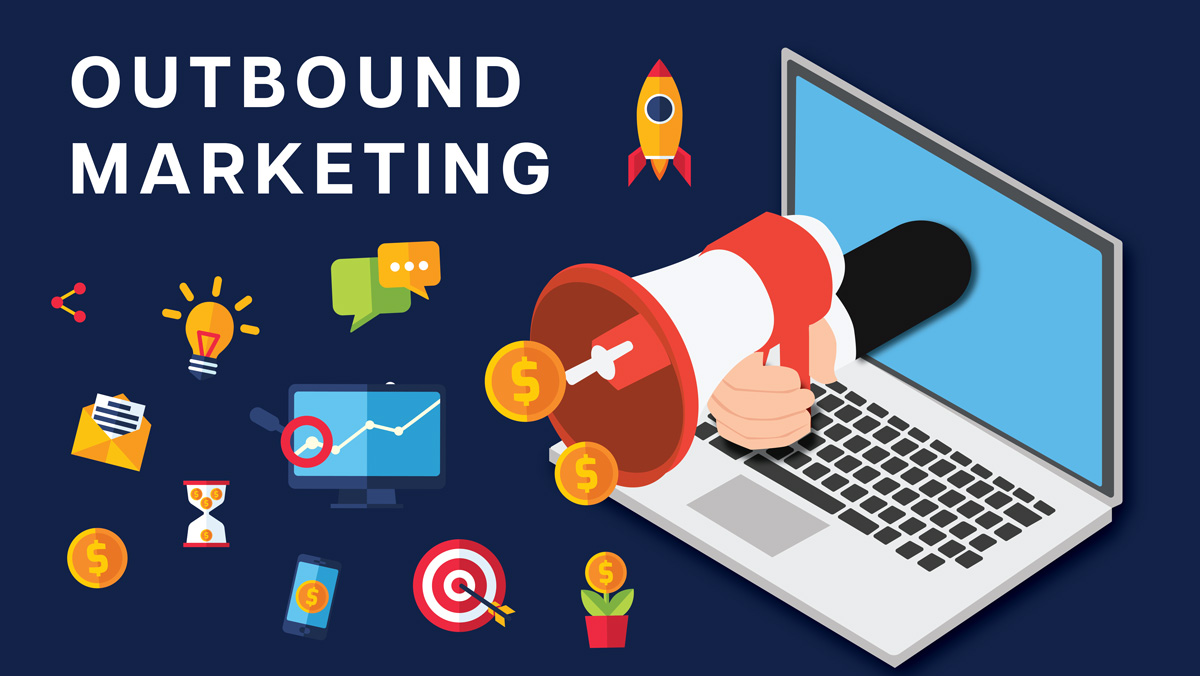How would a company get the word out about a new product launch? Outbound marketing is the type of marketing in which a corporation begins an interaction and distributes its message to the targeted audience. A few of the examples are conventional marketing like TV commercials, advertisements on the radio, ads in newspapers, magazines, etc. Following the generation of leads through some of these strategies means that it has traditionally been the role of a firm’s sales staff to follow up with those clients and create commercial ties.
So, What is Outbound Marketing?
Organizations use outbound marketing to spread a broad network and seek to obtain consumers by constantly advertising their content to a pool of consumers without considering whether these messages are accepted. This is known as ‘spamming’ in which a firm decides to break an individual’s flow of action to capture their focus and propagate the firm’s message. Outbound marketing can either raise brand visibility or alienate the customers.
Outbound marketing’s purpose is lead creation, making it crucial for firms seeking clients. It is the most effective strategy for new businesses to attract the largest potential population quickly.
What Are the Types of Outbound Marketing?
1. Traditional Advertising

Traditional advertising, often termed Above-The-Line (ATL) advertising, encompasses media that includes radio, newspapers, billboards, emails, etc. They advertise through brand awareness campaigns. Even though conventional advertising is often seen as ineffective, it is still very much in power as the customers who watch television, switch on the radio, or read the newspaper every morning have not decreased.
2. Digital Advertising

The digital industry is growing rapidly. You can reach your audience with digital advertisements depending on geographic, economic, behavioral segmentation, behavioral attributes, preferences, and habits. Retargeting and customized viewers are complex marketing methods that can help you connect with a bigger audience. Because of their precision in targeting methods, digital ads are classified as Below-The-Line (BTL) advertising.
Some examples of digital ads include:
- Search Engine Marketing (SEM)
- Display Advertising
- Social Media Advertising
- Over-The-Top Advertising
- Email Advertising
- Native Advertising
- Video Advertising
3. Through The Line Advertising
Through-the-line advertising consists of ATL and BTL advertising types. TTL includes Digital-Out-of-Home (DOOH) advertising, a new advertising technique that displays interactive commercials on traditional outdoor media.
4. Cold Calling
These are also known as telemarketing. In cold calling, the salesman makes cold calls to a list of people who potentially be possibilities to measure their willingness and persuade them into future clients. “Cold calling” refers to a salesman calling a customer without prior contact with him. Warm calling in telemarketing is a method after a client has shown a desire for your products.
5. Email Marketing

Email marketing allows firms to communicate with a large user base to uncover new prospects. Below are a few examples of email marketing that can be sent to a customer:
- Email sequence for welcome and onboarding
- Campaigns for lead creation, mentoring, and follow-up
- Weekly bulletins
- Launch of a new product/features
- Product comments and a survey
- Campaigns for customer retention
- Emails for upselling or cross-selling
- Emails about cart abandonment
- Discounts, promotions, and customer loyalty programs
6. Content Syndication
Posting materials on a third-party website is called content syndication. It can be anything ranging from a guest post, a powerful content piece, an interview, or a reprint of an existing article. Content syndication may also occur via endorsement deals, in which you collaborate with some other company to develop an engaging article for the audience.
Outbound Marketing Is Beneficial For What Types of Customers?
The more senior the consumer, the greater the likelihood that outbound marketing will influence them. It is the type of marketing that people from the older generation are accustomed to. The older generation has a habit of reading the newspaper or listening to the radio ads for new products. Therefore, it becomes relatively easy to attract them and sell the products. It is also successful in business marketing or deals producing high items.
What Are The Advantages of Outbound Marketing?
Outbound marketing methods, when used wisely, are a crucial component of a well-balanced, comprehensive, and successful marketing program. Below are a few advantages of outbound marketing:
1. Easier to Implement
Content marketing is an effective channel. It is, however, time-consuming! Small organizations may not always have the resources or time to establish a great content presence to produce enough profit. Outbound marketing strategies, on the other hand, such as placing letters in mailboxes, running social advertisements, and advertising in open places, are typically more effective.
2. Immediate Outcome
Local firms need to generate money regularly to be sustainable. While a large organization may be unaffected by a bad month or two, a small firm may go bankrupt in similar circumstances. Compared to large and time-consuming inbound advertising, outbound marketing produces faster performance and enhances customer understanding.
3. Easier Targeting
Several local firms concentrate their marketing efforts on nearby areas, making outbound operations considerably easier. You can purchase a spot on a local radio station or a poster and probably find an audience in your intended area rather than a brand name with a broad audience.
4. Customers Can't Miss It
The most significant benefit of having outbound advertising is that you can attract a large number of people. This comprises loyal clients, individuals who have known you and have never even bought from you, and those who are inexperienced with your products. A diverse audience encourages brand awareness.
But, Are There Any Disadvantages Of Outbound Marketing?
Yes, probably, there are some disadvantages to this type of marketing. These include –
1. Acquiring Leads Can Be Expensive
When a particular lead is gained by outbound marketing, the cost is higher than when the lead is generated via inbound marketing. Gaining information via inbound marketing is now, on average, 61% less expensive than developing a lead via outward advertising methods.
2. Outbound Marketing Efforts Are Less Popular
While developing an efficient outbound business strategy, it is critical to avoid being overly demanding. This is because many individuals resent being forced to participate in a company’s or business’s promotional activities. It is important to keep your strategy to a minimum. If the outbound advertising strategy is excessively obtrusive, it could have the opposite impact and turn consumers off. To put it another way, it’s essential not to overuse it.
3. Customers Are Not As Readily Tempted
Consumers are growing more knowledgeable; they want to acquire stuff for themselves without being sidetracked by advertisements. In reality, only 10% of web clicks are created by advertising, while over 90% are made by inbound lead generation.
4. Avoiding Advertisements
The major drawback of advertising methods is that consumers nowadays stop paying attention to this type of item, especially advertisements. Customers constantly avoid advertisements by unfollowing email lists, avoiding cold calls, ignoring websites with excessive advertising, and skipping television commercials.
How To Develop An Outbound Marketing Approach?
Is it possible to develop an effective outbound marketing approach for the growth of sales?Yes, it is, and here are some strategies to do the same!
1. Knowing Your Offerings
It is essential to choose the platforms wisely for promoting your products. Given the magnitude of the intended audience, businesses can be marketed via mainstream media. It is best to be precise about your marketing strategies. Customers get addicted to discounts and promo codes.
2. Knowing Your Targeted Audience
Developing customer profile examples can assist you in determining the best marketing channels to advertise your services. This includes choosing the best platforms to sell your products, analyzing your audience’s behaviors, media consumption patterns, etc.
3. Research About Your Competitors
Outbound marketing flourishes on competitiveness. Advertising strategies are overloaded, and firms must continue outperforming their opponents if they want to be recognized. As a result, it is crucial to keep a watch on your rivals. Look at their strategies, how they are accomplishing and what they are losing, and figure out how to differentiate yourself from them.
One of the most prevalent strategies for outsmarting opponents is ambush/guerrilla marketing. Ambush marketing involves businesses using an unexpected approach to being recognized and standing out, leading to battles between opponents.
Here is the most famous guerrilla marketing strategy used by Coca-Cola and Pepsi against each other.
4. Creating Campaign Message
Create a list of important points you wish to convey to your audiences. Ideally, the campaign strategy should include the name of the campaign, title, tagline, and hashtags. While making anything viral is difficult, adopting narrative approaches that promote audience interaction may boost engagement. The branding must reflect the benefits customers will subtly receive from your services. It should also elicit an emotional response from viewers or be distinctive enough to ensure brand recognition.
5. Choose Your Platforms
Your marketing strategy must emphasize the promotional tools you want to execute your campaign. It might be online, offline, or a combination of the two. The funding should be properly allocated to guarantee that the campaign receives the appropriate exposure across all social networks.
After narrowing down the platforms, developing a plan for each medium is important. For online advertisements, for example, you must prepare the target demographic, creative ad types, pricing, etc. Likewise, you may need to collaborate with an advertising firm to complete the media purchase procedure for newspaper advertisements.
Conclusion
The most successful market strategy is the one that suits your business well. Trying new methods constantly can benefit your firm, but stick to some familiar strategies. Examine your data promptly and note significant changes that occur. Always remember that viewers change. Whatever worked last year might not even work again. Consumers often get tired of the same strategies. Balancing between inbound and outbound marketing strategies is important to running a steady business.




